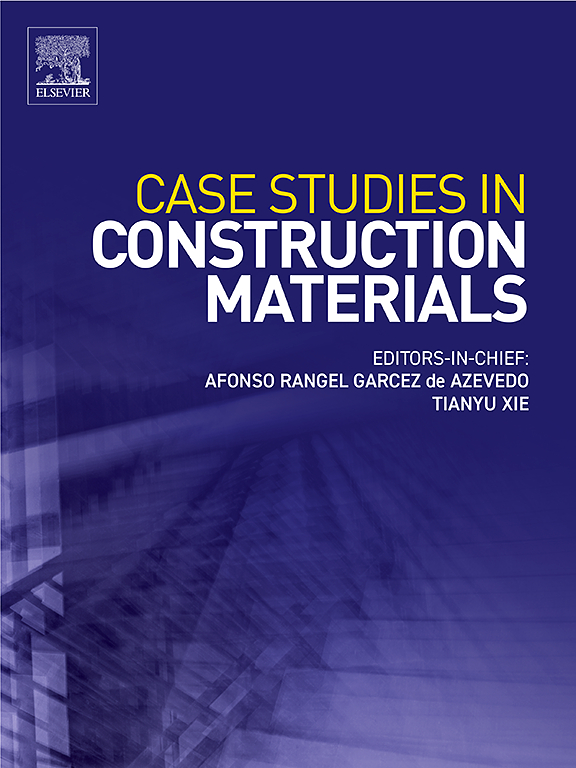Experimental assessment on mechanical performance of precast concrete sandwich panels manufactured with mixed recycled aggregate
IF 6.6
2区 工程技术
Q1 CONSTRUCTION & BUILDING TECHNOLOGY
引用次数: 0
Abstract
Mixed recycled coarse aggregate (MRA), derived from construction and demolition waste of masonry-concrete composite frame structures, primarily consists of recycled concrete aggregate (RCA) and recycled brick aggregate (RBA). Due to the high porosity of MRA, its application to precast concrete sandwich wall panels (PCSPs) is beneficial for improving their thermal performance. However, the influence of MRA on the mechanical properties of such sandwich panels remains inadequately characterized. This study presents experimental findings on the axial and flexural behavior of PCSPs incorporating MRA (MRA-PCSPs). Results show that with a 50 % MRA replacement rate, the axial and flexural bearing capacities of the panels decreased by 15.7 % and 6.7 %, respectively. Compared with bending performance, MRA has a more significant adverse effect on axial compression performance. When the RBA content in MRA increased from 10 % to 30 %, the cracking loads under axial compression and bending tests decreased by 24.7 % and 15.1 %, respectively, but the ultimate load was not adversely affected. While the inclusion of MRA did not compromise the composite action of PCSPs, using a thicker insulation board led to reductions in both the load-bearing capacity and composite performance. The addition of edge frames significantly enhanced the mechanical performance of MRA-PCSPs, increasing their axial and flexural bearing capacities by 23.6 % and 204.5 %, respectively. The composite action of the wall panels is significantly enhanced after adding edge frames, which is basically equivalent to solid wall panels.
混合再生骨料预制混凝土夹芯板力学性能试验评价
混合再生粗骨料(MRA)主要由再生混凝土骨料(RCA)和再生砖骨料(RBA)组成,来源于砖混复合框架结构的建筑和拆除废弃物。由于MRA的高孔隙率,将其应用于预制混凝土夹芯墙板(pcsp)中有利于改善其热工性能。然而,MRA对这种夹芯板力学性能的影响仍然没有充分的表征。本研究提出了包含MRA的PCSPs (MRA-PCSPs)的轴向和弯曲行为的实验结果。结果表明,当MRA替换率为 % 50时,面板的轴向和弯曲承载力分别下降了15.7% %和6.7 %。与弯曲性能相比,MRA对轴压性能的不利影响更为显著。当MRA中RBA含量从10 %增加到30 %时,轴压和弯曲试验的开裂载荷分别降低24.7 %和15.1 %,但对极限载荷没有影响。虽然含有MRA不会影响pcsp的复合作用,但使用较厚的绝缘板会导致承重能力和复合性能的降低。边缘框架的加入显著提高了mra - pcsp的力学性能,其轴向和弯曲承载能力分别提高了23.6% %和204.5 %。加边框后墙板的复合作用明显增强,基本相当于实心墙板。
本文章由计算机程序翻译,如有差异,请以英文原文为准。
求助全文
约1分钟内获得全文
求助全文
来源期刊

Case Studies in Construction Materials
Multiple-
CiteScore
7.60
自引率
19.40%
发文量
842
审稿时长
63 days
期刊介绍:
Case Studies in Construction Materials provides a forum for the rapid publication of short, structured Case Studies on construction materials. In addition, the journal also publishes related Short Communications, Full length research article and Comprehensive review papers (by invitation).
The journal will provide an essential compendium of case studies for practicing engineers, designers, researchers and other practitioners who are interested in all aspects construction materials. The journal will publish new and novel case studies, but will also provide a forum for the publication of high quality descriptions of classic construction material problems and solutions.
 求助内容:
求助内容: 应助结果提醒方式:
应助结果提醒方式:


